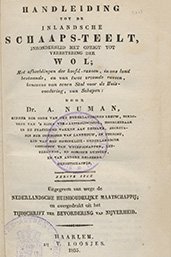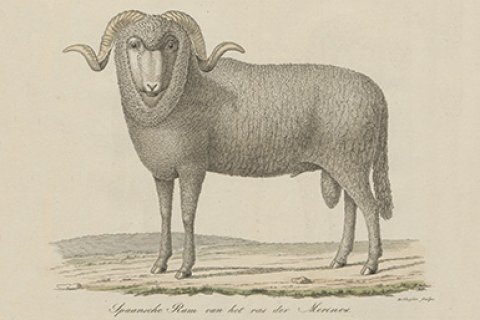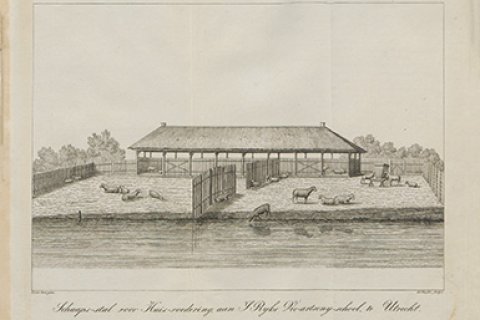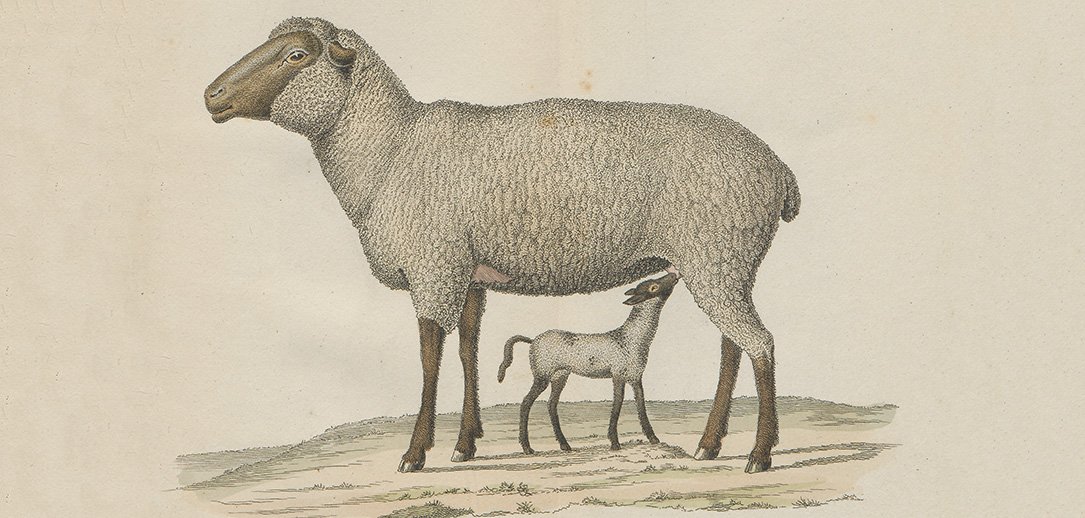'Handleiding tot de inlandsche schaaps-teelt' by Alexander Numan
Counting sheep

The Handleiding tot de inlandsche schaapsteelt (1835-1836) (‘Introduction to indigenous sheep breeding’) is the first Dutch handbook in the field of sheep farming and breeding. The author, Alexander Numan (1780-1852) was a doctor, professor, director of the Rijks Veeartsenijschool (‘State Veterinary School’), and founder of Veterinary Medicine in the Netherlands. The book was written during the reign of Willem I, the merchant-king who, in 1825, had information collected about the possibilities to improve the Dutch sheep breeds, thus bringing the quality of their wool to a higher standard. But did it have the desired results?
Experiments
Numan readily attended to the king’s wishes by building up a flock of sheep which he used for improvement experiments. To do this job properly, he made a study of all that had been published on that subject up to that time and reported his findings in the journal Tijdschrift ter bevordering van nijverheid. Later on, his articles were collected in the Handleiding, in two parts. Numan was very thorough in his handbook. He started with the origin of sheep and with the breeds which existed in each Dutch province, including the good use that was made of sheep. Next he discusses the question how Dutch sheep and particularly their wool could be improved. He thought the best method would be to cross Dutch sheep with foreign breeds that were already improved. Next he discusses what was known about sheep, and how they should be fed and cared for. An important chapter is dedicated to sexual reproduction and methods of improving sheep. Finally, there is an appendix in which Numan writes about the Merino sheep and the Southdown sheep, two foreign breeds that were used for crossbreeding in the Netherlands.
Wool or meat

When Numan wrote his handbook, his own experiments were in full swing. He crossbred Dutch sheep with some English breeds, including the New Leicester, bred by the famous English breeder Bakewell, and the Southdown. In this way he hoped to improve the rather poor quality of the wool produced by Dutch sheep. This strategy was not very successful, as the Dutch industry showed no interest in improved wool. Dutch wool may not have been very fine, and therefore not suitable for better quality clothing, but could be used for other products such as stockings and knitted caps. Moreover, a good price was paid. Finer wool was imported from abroad, especially from the middle of the 19th century, when Australia and New Zealand started a grand-scale production of fine quality wool. As a result, in Europe, and also in the Netherlands, attention shifted from the production of wool to the production of meat. With his focus on improving wool Numan betted on the wrong sheep so to speak.
Results

All the same, his work had its use for the Dutch sheep breeding. As said before, his handbook was the first extensive guide in this field. His experiments showed that English breeds not only improved the wool, but also the meat. In the 19th century meat improvement would become the road to follow, resulting in the origin of the Texelaar at the end of the 19th century, one of the best meat breeds in the world.
Copies
The copy here digitized (ODJ 6077) has both parts in one volume (digitally separated in part 1 and part 2). On the title page are stamps of the Vee-Artseny-School (‘Veterinary School’, founded in 1821) and the Maatschappij ter bevordering der veeartsenijkunde in Nederland (‘Society for the promotion of vetenary medicine in the Netherlands’, founded in 1846, established by Royal Decree in 1862). On the flyleaf is a stamp of the library of the Veterinaire Faculteit Utrecht, from the period after 1925, when the Rijksveeartsenijschool became part of Utrecht University. It is one of many books and manuscripts that were transferred from the former libraries of Veterinary Medicine to the University Library of Utrecht. Among them is also an interleaved copy of the Handleiding tot de inlandsche schaapsteelt (Ms 14 E 14-15) with a couple of corrections and annotations made by Numan himself. On the flyleaf of part one is a list of persons to whom he had given a copy as a gift.
Author
Bert Theunissen, April 2014


